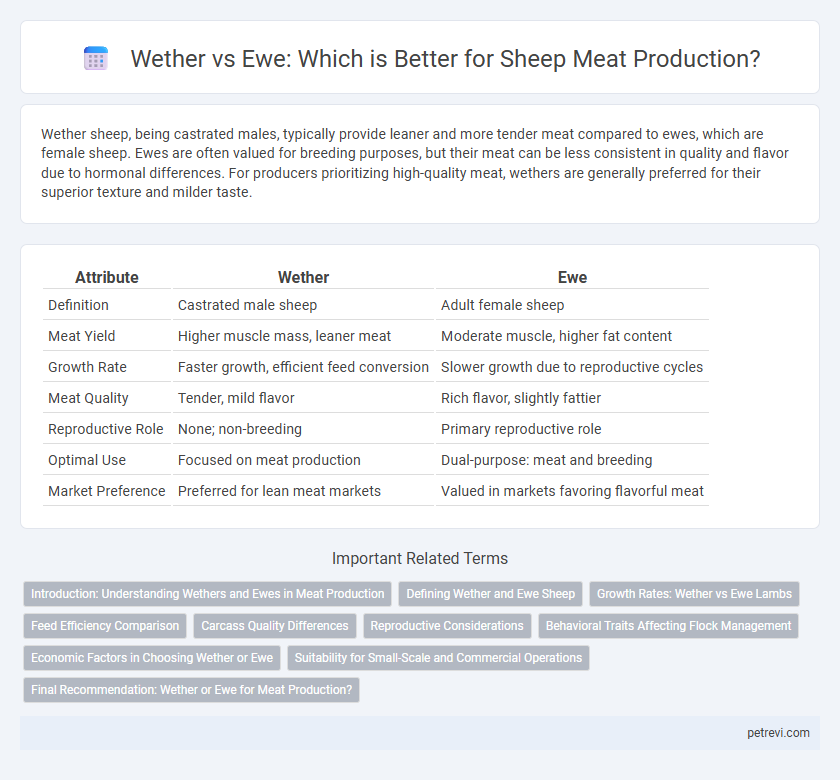Wether sheep, being castrated males, typically provide leaner and more tender meat compared to ewes, which are female sheep. Ewes are often valued for breeding purposes, but their meat can be less consistent in quality and flavor due to hormonal differences. For producers prioritizing high-quality meat, wethers are generally preferred for their superior texture and milder taste.
Table of Comparison
| Attribute | Wether | Ewe |
|---|---|---|
| Definition | Castrated male sheep | Adult female sheep |
| Meat Yield | Higher muscle mass, leaner meat | Moderate muscle, higher fat content |
| Growth Rate | Faster growth, efficient feed conversion | Slower growth due to reproductive cycles |
| Meat Quality | Tender, mild flavor | Rich flavor, slightly fattier |
| Reproductive Role | None; non-breeding | Primary reproductive role |
| Optimal Use | Focused on meat production | Dual-purpose: meat and breeding |
| Market Preference | Preferred for lean meat markets | Valued in markets favoring flavorful meat |
Introduction: Understanding Wethers and Ewes in Meat Production
Wethers, castrated male sheep, are often preferred in meat production due to their steady growth rates and leaner carcasses compared to ewes. Ewes, female sheep, offer the advantage of reproductive capacity but may carry more fat, affecting meat quality and yield. Understanding the physiological differences between wethers and ewes helps optimize sheep meat production efficiency and market preferences.
Defining Wether and Ewe Sheep
Wether sheep are castrated male sheep primarily raised for their meat quality and calmer behavior, which enhances feed efficiency and carcass consistency. Ewe sheep are adult females valued for their reproductive abilities and maternal instincts, often contributing to flock sustainability alongside meat production. Understanding the distinction between wether and ewe sheep is crucial for optimizing breeding strategies and meat yield in sheep farming.
Growth Rates: Wether vs Ewe Lambs
Wether lambs typically exhibit faster growth rates compared to ewe lambs due to their lack of reproductive hormones, which allows more energy to be directed towards muscle development and weight gain. Studies show wether lambs can achieve market weight several weeks earlier than ewes under comparable feeding regimes. This advantage in growth efficiency makes wether lambs a preferred choice for producers prioritizing rapid meat yield and feed conversion.
Feed Efficiency Comparison
Wether sheep, being castrated males, generally exhibit better feed efficiency compared to ewes due to their increased muscle mass and lower maintenance energy requirements, which translates to higher meat yield per unit of feed consumed. Ewes, while valuable for reproduction, tend to have higher energy demands for reproduction and lactation, reducing their feed-to-meat conversion ratio. Studies indicate that selecting wethers for meat production optimizes feed utilization and growth rates, making them more cost-effective for meat-focused operations.
Carcass Quality Differences
Wether sheep, being castrated males, typically exhibit more consistent fat distribution and heavier carcasses, which contributes to improved meat tenderness and flavor compared to ewes. Ewe carcasses often have leaner meat with less intramuscular fat, leading to a slightly firmer texture but potentially lower palatability. The hormonal differences between wethers and ewes significantly influence carcass composition, affecting both yield and overall meat quality in commercial sheep meat production.
Reproductive Considerations
Wethers, being castrated males, do not contribute to reproduction but are often preferred for consistent meat quality due to their hormone levels, while ewes, as female sheep, play a critical role in lamb production and flock sustainability. Ewes' reproductive efficiency directly influences lamb crop yield and future meat supply, making their breeding management essential for meat production optimization. Selecting between wethers and ewes involves balancing the need for reproduction through ewes and meat quality traits from wethers.
Behavioral Traits Affecting Flock Management
Wethers exhibit calmer and more predictable behavior compared to ewes, making flock management easier and reducing stress during handling and shearing. Ewes often demonstrate stronger maternal instincts and protective behaviors, which can complicate management but are crucial for lamb survival and care. Understanding these behavioral traits helps optimize handling routines, improve welfare, and enhance overall productivity in sheep meat production.
Economic Factors in Choosing Wether or Ewe
Wethers typically offer higher meat yield and more consistent carcass quality, making them economically advantageous for meat production due to better feed conversion rates and faster weight gain compared to ewes. Ewes, while producing slightly less meat, contribute additional revenue streams through lambing potential, which can offset lower individual meat yields. Producers must weigh the immediate economic benefits of wethers against the reproductive value of ewes when optimizing profitability in sheep meat production.
Suitability for Small-Scale and Commercial Operations
Wethers offer consistent meat quality and faster growth rates, making them highly suitable for both small-scale and commercial sheep meat production. Ewes provide the added benefit of breeding potential but may have slower growth and leaner carcasses, which can impact meat yield in commercial operations. Small-scale producers often favor wethers for ease of management and predictable meat output, while commercial operations balance the use of ewes for flock sustainability alongside wethers to maximize meat production efficiency.
Final Recommendation: Wether or Ewe for Meat Production?
Wethers often outperform ewes in meat production due to their higher feed efficiency and superior carcass quality, delivering more consistent and leaner cuts. Ewes contribute additional value through lamb production but tend to deposit more fat, which can affect meat yield and market preferences. For optimized meat production focused solely on quantity and quality, wethers are generally the recommended choice.
Wether vs Ewe for Sheep Meat Production Infographic

 petrevi.com
petrevi.com